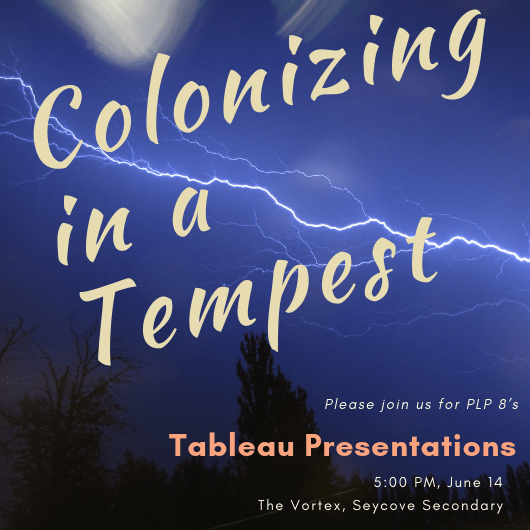Hello ladies, gents, aliens, etc… welcome back to my blog for another episode of, “Torture With Willemse!” Obviously I’m kidding, or at least I hope its obvious. Anyway if you aren’t familiar with my many, many humanities posts added to this portfolio you should seriously check them out cause these projects are awesome. Moving on, in my final term of grade 8 PLP I have experienced Shakespeare like no other in PLP 8’s, “Colonizing in a Tempest!” 
So what is Colonizing in a Tempest? Easy answer. Basically, our teacher decided that combining the historically significant events of New France and the first European colonizations of what is now Canada and Shakespeare’s play, “The Tempest,” would give us a unique perspective on the two subjects. As a result we staged dramatic tableaus from “The Tempest” set in New France. This project was one of my favourite and one of the most stressful as our teachers were on a field study with the grade 10’s for two weeks leaving us with multiple TOC’s. Very stressful business! As I am talking about a PLP project, there has to be milestones with many, many stepping stones that got us to the final presentation. Only a few really helped me gain a true understanding of both the history and the play itself.
Among the stepping stones that started us off after our initial launch came our anthropology viewpoint milestone. This basically challenged us to grasp a solid understanding of how the different viewpoints of an anthropologist. We studied terms like cultural superiority, imperialism, ethnocentrism, and a few more for a week or so in order to understand that in the process of first contact between First Peoples and Europeans viewpoints were flawed. This milestone helped me grasp more than a basic understanding of the topic in question and stared me off on a path of deeper meaning and constantly searching for that during the rest of this project.
The next steps in this mega project included reading and writing about some of the history. We covered things like treaties and wars. We moved through the beginnings of the fur trade and came to a halt at the expansion of small companies. When the european colonists and traders set up efforts all throughout New France, some along the border of British territory. This is when companies such as the infamous Hudson’s Bay Co. were started and only few thrived through the beaver wars. In learning about all of this we wrote paragraphs that showed our understanding and only one really stood out to me. The assignment entitled, “why did the First Nations choose to trade with the Europeans?” So why did this challenge me? I found that with this assignment I took the time to really think and try my best to see both sides in order to grasp an unbiased opinion on the question at hand.
My absolute favourite milestone was our timeline. I love history. From peace and war, to government, religion, and exploration I can’t get enough. I found that with every project this year, the history has been the easiest thing to understand. Learning how to read and grasp the full Shakespeare experience was a daunting task for me but I found that with time and some close examination, I learned to read and comprehend it to the best of my current abilities. Moving back to our timeline. When combining the main scenes in each act of the play, with the historically significant events we needed to keep track of how they coincided to make sense of it for the audience. We started around first contact between First Nations and Europeans and aligned it with the first contact between the plays main character, Prospero and the shipwrecked nobleman from Naples. For each scene we needed to come up with a solid plan for the parallel history. In doing so we made a huge timeline stretching from 1600 to 1765. This was the point in the project where everything was beginning to make total sense. This final milestone was the one that has helped me answer the driving question, “How can we use Shakespeare’s, The Tempest, to stage dramatic tableaus and show the lasting effects of colonization to an audience?”
This final play was truly amazing and I loved every moment from costume set up to rehearsal and backstage coordinations. I think that we absolutely answered the driving question and I’m really proud that we could. The question in itself can’t really be answered without the play but I can take a risky shot. I believe that we allowed for the audience to understand the lasting effects of colonization through the dramatic tableaus we performed. In doing so we showed how the play aligns with the most historically significant events in the history of New France. That might not have been much of an answer to the question if you think of it as a very literal thing, but from a different perspective it answers the question by me simply saying that my 7 year old sister could basically repeat the history and big events to me afterwards.
See ya’ll for about one more post in my PLP 8 year. It’s been great guys!
– Ciara ✌️




